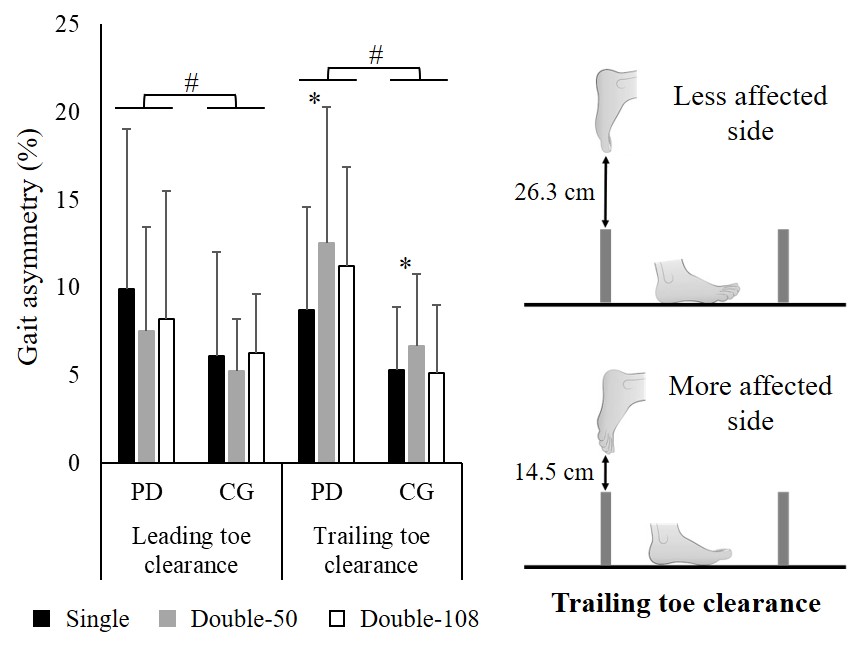By Dr Diego Orcioli-Silva.
Gait asymmetry is the difference between the left and right limbs during walking. Such gait asymmetry has been associated with trips and falls during walking in people with Parkinson’s disease (PD). Gait asymmetry is exacerbated under more complex tasks. We often encounter one or more obstacles in our pathway, which may reflect a more complex task. Indeed, a previous study showed that people with PD presented higher gait asymmetry during obstacle crossing. However, in environments with double obstacles (i.e. one shoe box after the other or a hole followed by a tree trunk on the path), gait asymmetry remains poorly understood in PD. In this study, we analyzed gait asymmetry while crossing a single obstacle and double obstacles (with different distances between them) in 19 people with PD and 19 healthy older people. Participants walked at their preferred speed on a pathway in three conditions: (i) with one obstacle (Single); (ii) with two obstacles with a 50 cm distance between them (Double-50); (iii) with two obstacles with a 108 cm distance between them (Double-108). To allow us to calculate gait assymetry, participants did all conditions with both limbs leading. We assessed gait parameters and distance between foot and obstacle. Our analysis showed that both people with PD and healthy older people increased trailing toe clearance asymmetry in the Double-50 compared to Single condition. In addition, people with PD presented higher leading and trailing toe clearance asymmetry than healthy older people (Figure 1).
In this study, we found that a more complex environment increases asymmetry during obstacle crossing in both healthy older people and people with PD. We also found that independently of the number of obstacles and compared with healthy older people, people with PD presented higher toe clearance asymmetry; a behaviour likely to increase their risk of tripping over obstacles. In fact, toe clearance seems to depend on which limb crosses the obstacle first. This means that people with PD may present a shorter toe clearance if they step over the obstacle with the more affected lower limb first and are therefore more likely to contact the obstacle in this instance. Overall our results suggest that rehabilitation strategies should focus on unilateral exercises (e.g., strength exercises) and involve gait tasks performed in challenging environments to enhance the functional capacity and gait performance in PD.

Figure. Left: Bar graphs of means and standard deviations of leading and trailing toe clearance asymmetry. Right: Illustration of trailing toe clearance for each lower limb of one individual with PD during Double-50 condition. * represents the significant differences between Single vs. Double-50 condition. # represents the significant differences between people with Parkinson’s disease (PD) and healthy older people (CG).
Publication
Orcioli-Silva D., Barbieri F.A., dos Santos P.C.R., Beretta V.S., Simieli L., Vitorio R., Lirani-Silva E. and Gobbi L.T.B. Double obstacles increase gait asymmetry during obstacle crossing in people with Parkinson’s disease and healthy older adults: A pilot study. Sci Rep 10, 2272 (2020).
About the Author

Diego Orcioli-Silva
São Paulo State University (UNESP), Institute of Biosciences, Posture and Gait Studies Laboratory (LEPLO), Rio Claro, Brazil.
Diego Orcioli-Silva has recently concluded his PhD at the São Paulo State University (UNESP). His research focuses on neuroscience, motor control, gait and Parkinson’s disease. Currently, he is investigating the cortical correlates of walking in people with PD using EEG and fNIRS systems.
Copyright
© 2020 by the author. Except as otherwise noted, the ISPGR blog, including its text and figures, is licensed under a Creative Commons Attribution-ShareAlike 4.0 International License. To view a copy of this license, visit https://creativecommons.org/licenses/by-sa/4.0/legalcode.
ISPGR blog (ISSN 2561-4703)
Are you interested in writing a blog post for the ISPGR website? If so, please email the ISGPR Secretariat with the following information:
- First and Last Name
- Institution/Affiliation
- Paper you will be referencing


